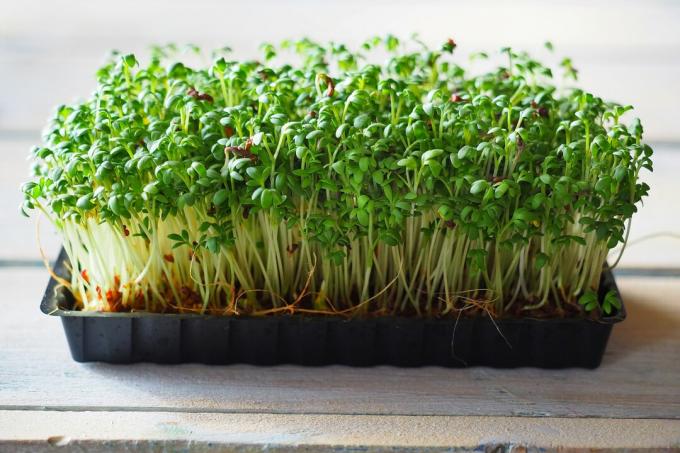Cress seedlings are well suited to decorate any dish. But also because of the ingredients and flavor it is worth growing this herb all year round.

has its origin garden cress (Lepidium sativum) probably in Asia. But the strengths of this dainty culinary herb were known around the world early on. Thus, in ancient Egypt, seeds of the cruciferous family (Brasicacea) found as a grave supplement during excavations. Charlemagne once ordered the cultivation of the herb on the European continent. Because the garden cress can not only shine with its spice for refining delicious dishes. The high content of vitamin C, iron, calcium and folic acid can be a valuable and energy-giving addition to a lack of fruit and vegetables, especially in winter. We give you the right tips on how you can successfully grow this tiny plant, which is bursting with strength and heat, all year round.
contents
- 1. location
- 2. sowing
- 3. watering and fertilizing
- 4. wintering
- 5. harvest
- 6. storage
1. location
Outdoors, a sunny location is beneficial, but not absolutely necessary. The garden cress is also satisfied with a shady spot - then it just takes a few days longer until the herb is ready for harvest. When growing indoors, a light window sill should also be preferred. The annual garden cress is also frighteningly undemanding in terms of nutrients. It would be happy about a sufficient supply via the substrate, but even a poor substrate does not become a disadvantage in the cultivation of garden cress. If you want to create the best conditions for your garden cress, use a high-quality substrate such as our peat-free Plantura Organic universal soil.
2. sowing
Garden cress is only propagated by sowing. Outdoors, this should not be done before mid-May. The seedlings need a minimum temperature of 15 °C to germinate and are also very sensitive to frost. With a suitable germination temperature, the seeds sprout after just one day and are ready for consumption after four days at a growth temperature of around 20 °C. When growing indoors, year-round sowing is possible. In addition, substrates such as cotton wool or damp kitchen paper can be used. These have the advantage that, in contrast to earthy substrates, they are not contaminated with germs. These pathogens could quickly become dangerous for the sensitive garden cress. If you prefer a culture in soil, heat the substrate in the oven before sowing. In this way you can reduce the pest pressure in the substrate. Also to be noted: garden cress is a so-called light germinator. For this reason, the seed should not be covered with a substrate layer that protects it from drying out, as is usually the case. Therefore, when sowing garden cress, even more care must be taken to avoid drying out the swelling seed. You should regularly moisten the seed with a finely atomized jet of water.

3. watering and fertilizing
Fertilization can be completely ignored with this extremely undemanding herb. Especially during the germination process - regardless of whether it is sown in soil or on cotton wool - the germinating seed must be kept well moist. After that, the seedling will enjoy an even supply of water.
4. wintering
The question of hibernation is not necessary with the garden cress. It is an annual herb. This means that the frost would kill her pretty quickly outdoors. The only way to enjoy specially grown garden cress all year round is to cultivate it on the window sill.
5. harvest
If the garden cress is treated to a constant temperature of around 20 °C, it will be ready for harvest after just four days. To do this, the seedlings are simply cut off with scissors just above the substrate surface. The cress can be harvested until flowering. However, if you should not be able to do this, you can simply let the plants wither away. The seed can then be harvested and sown again. Due to the short culture time of the cress, it makes sense to regularly (e.g. B. every two weeks). This ensures that fresh watercress is always available. More details on Harvesting cress we have summarized for you in this article.
6. storage
Garden cress should only be used fresh. Neither drying nor freezing are suitable for preserving this spicy herb. The cress should be put on the plate immediately after cutting, because after just a few hours it noticeably loses its characteristic aroma. So one more reason to regularly sow garden cress and thus always have the spicy vitamin bomb fresh at hand.
